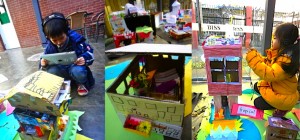This post describes our first foray into the world of augmented reality.
It began with play, the basis of all learning. Through experimentation, our teachers explored the functionality, idiosyncrasies and scope of Aurasma. In essence, this app provides image recognition technology, so that real objects can be overlaid with media. In no time, we had a wealth of ideas for how this tool could enhance student inquiries.
These are our first 2 attempts with augmented reality:
Grade 4 Ancient History Museum
During a research cycle, each student produced a written report and a series of artefacts. The artefacts represented key legacies of their chosen civilisation. Then, students created videos, taking on the role of archeologists, to explain where they had found the artefact, what it was made of/used for, how it survived and why it represented an important legacy. These videos were used as auras, with the artefacts as trigger images.The classroom was then transformed into a museum. When visitors arrived, they saw written reports and interesting fragments of the ancient world. Then, armed with an iPad, the artefacts came to life! Just like a self-guided tour, as they held the iPad over each object, the guests were treated to an in-depth explanation from a student archeologist.
Grade 1 Box World
Grade 1 students inquired into homes. They learned that homes reflect people’s needs, culture and environment. Using boxes, egg cartons, toilet rolls and the contents of every recycling bin, these little builders created unique structures, complete with adaptations for the environment (e.g. stilts for houses by rivers, insulation for cold climates) and decorations to represent their cultural background or personal preferences. Using iPads, each child then made their own video, explaining all the important features. A little nauseating, but perfectly delightful, these young film-makers proudly showed us top-views of chimneys, spun underneath balconies and zoomed-in on matchbox furniture, all with real-time narration. These videos became auras, with the homes as the trigger image. Finally, the homes were set up as a giant world, complete with paper roads, rivers and mountains to demarcate each environment. When people visited, they too were armed with iPads and marvelled at the knowledgeable explanation that accompanied each structure.
(Box World by Lara Ronalds and ever-patient tech integration by Anna Davies.)
So What?
 In each example, Aurasma was not used as a flashy toy. Instead, students used it as a tool to explain the scope and depth of their understanding. It would not have been possible to appreciate their learning, simply by viewing the products (i.e. a crooked cardboard home or a painted clay fragment). In these examples, augmented reality allowed the students to synthesise their understanding and provide the audience with great insight into the products on display.
In each example, Aurasma was not used as a flashy toy. Instead, students used it as a tool to explain the scope and depth of their understanding. It would not have been possible to appreciate their learning, simply by viewing the products (i.e. a crooked cardboard home or a painted clay fragment). In these examples, augmented reality allowed the students to synthesise their understanding and provide the audience with great insight into the products on display.
The installations also stayed in place for a full school week, as more & more visitors came to explore, watch and listen. The students did not stand in place to repeat their explanations countless times. In all, a great success for students as creators of media and communicators of understanding!
To learn more, follow Brad & Drew, the experts in the field!
Read their brilliant blog on augmented reality for education.
One Comment
Join the conversation and post a comment.





Hi Shannon! I saw Katherine at the year 6 farewell and she mentioned your blog. Well done. Love to know what aurasmas (????) could look like at my school. Hope you are still enjoying the experience of OS. Kind regards
Shannon
Shannon